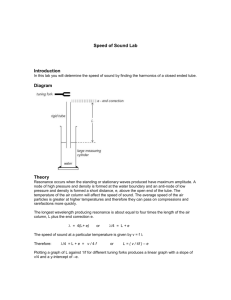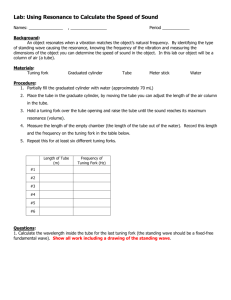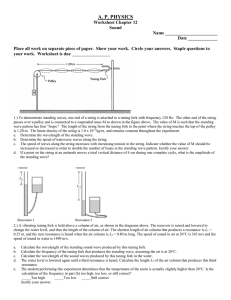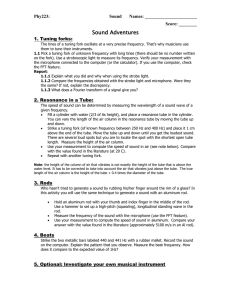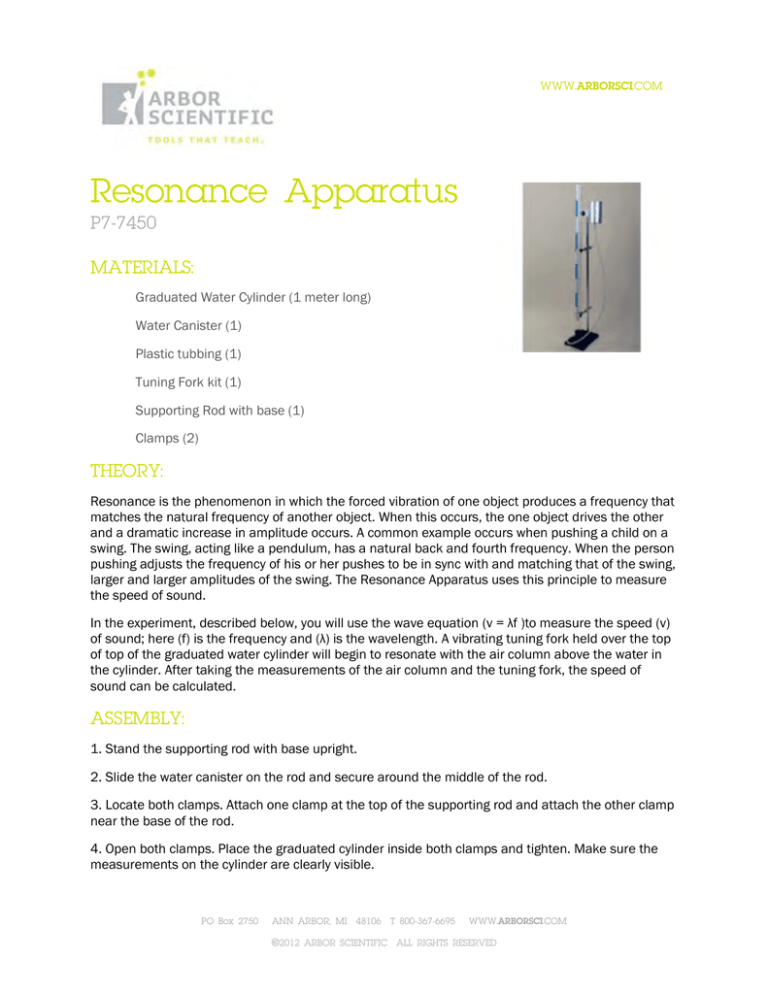
WWW.ARBORSCI.COM
Resonance Apparatus
P7-7450
MATERIALS:
Graduated Water Cylinder (1 meter long)
Water Canister (1)
Plastic tubbing (1)
Tuning Fork kit (1)
Supporting Rod with base (1)
Clamps (2)
THEORY:
Resonance is the phenomenon in which the forced vibration of one object produces a frequency that
matches the natural frequency of another object. When this occurs, the one object drives the other
and a dramatic increase in amplitude occurs. A common example occurs when pushing a child on a
swing. The swing, acting like a pendulum, has a natural back and fourth frequency. When the person
pushing adjusts the frequency of his or her pushes to be in sync with and matching that of the swing,
larger and larger amplitudes of the swing. The Resonance Apparatus uses this principle to measure
the speed of sound.
In the experiment, described below, you will use the wave equation (v = λf )to measure the speed (v)
of sound; here (f) is the frequency and (λ) is the wavelength. A vibrating tuning fork held over the top
of top of the graduated water cylinder will begin to resonate with the air column above the water in
the cylinder. After taking the measurements of the air column and the tuning fork, the speed of
sound can be calculated.
ASSEMBLY:
1. Stand the supporting rod with base upright.
2. Slide the water canister on the rod and secure around the middle of the rod.
3. Locate both clamps. Attach one clamp at the top of the supporting rod and attach the other clamp
near the base of the rod.
4. Open both clamps. Place the graduated cylinder inside both clamps and tighten. Make sure the
measurements on the cylinder are clearly visible.
PO Box 2750
ANN ARBOR, MI 48106 T 800-367-6695
WWW.ARBORSCI.COM
©2012 ARBOR SCIENTIFIC ALL RIGHTS RESERVED
5. Locate the plastic tubing. Attach one end of the tubing on the nozzle at the bottom of the
graduated cylinder.
Measuring the Speed of Sound in Air
Objective: The purpose of this experiment is to measure the speed of sound in air by exploring
standing wave and resonance effects in longitudinal waves.
Physics Theory:
You may have already examined the theory of standing waves and resonance in transverse waves
(standing waves on a string). In transverse waves, the displacement of the medium through which
the wave propagates is perpendicular to the direction of wave travel. Electromagnetic waves and
waves on strings are both examples of transverse waves. In longitudinal waves, the displacement of
the medium through which the wave propagates is parallel to the direction of wave travel. Sound
waves are a prominent example of longitudinal waves.
Recall that the condition for transverse standing wave formation on a string was v = 2lf/n or f =n v/2l
(n = 1, 2, 3, ...) where „f‟ is the frequency of vibration, „l‟ is the length of the medium (string), „n‟ is the
number of half wave lengths, „λ /2‟ (loops), and „v‟ is the propagation velocity of the wave. For sound
waves, this relationship still holds. In this experiment „f‟ is the frequency at which a column of air
vibrates (driven by a tuning fork), „l‟ is the length of the column of air, „n‟ is the number of half wave
lengths, „λ/2‟ and v is the speed of sound in air.
In this experiment, we will create longitudinal standing waves in a tube containing air in which the
tube is open at the top. By adjusting the amount of water in the tube, one may lengthen or shorten
the length, „l‟ of the column of air in the tube. If a tuning fork is held over the open end of the tube
and struck, it excites the air molecules in the tube and causes a sound wave to propagate down the
length of the tube to the air-water boundary, where it is reflected back up the length of the tube to
the open end. The end of the tube containing water constitutes a “closed” end. In tubes, pipes or
columns open at one end and closed at the other creates a stable standing wave pattern requires
that a displacement antinode exists at the open end and a displacement node at the closed end of
the tube. This means that the fundamental (first harmonic) standing wave, such as a tube, occurs
when the column of air is of length λ/4 . The series of nodes and antinodes in a tube, open at one
end and closed at the other, form an odd harmonic series. In tubes open at both ends, or closed at
both ends, all harmonics are possible. Thus the condition for a standing wave to form in a tube
closed at one end is f = n v/4l or λ = 4l/n (n=1,3,5,...).
Experimental:
In this experiment, the resonant frequencies are determined by the tuning forks that you will use to
produce standing waves in a column of air, within a tube that is open at one end. These are of known
value. By adjusting the level of water at the other end of the tube you will be able to adjust „l‟, the
length of the tube. In doing so you will be able to adjust the length of the column of air so as to form
standing waves in the tube. Once a standing wave of a given frequency has been established, by
adjusting the tube to the appropriate value of „l‟ for the fundamental of that particular frequency, it
will be possible to locate the position of each successive antinode along the wave by lengthening the
tube. By measuring the difference between successive nodes you will be able to compute the
wavelength of the standing wave; and from that, the speed of sound in the column of air by:
v = λf. Remember that the distance between successive antinodes is half a wavelength.
Fill the reservoir of the resonance apparatus with water positioning it near the bottom of the tube
before doing this to prevent overflow. Note how moving the reservoir up and down the attachment
rod raises and lowers the level of water in the resonance tube. Begin with the 256 Hz tuning fork.
PO Box 2750
ANN ARBOR, MI 48106 T 800-367-6695
WWW.ARBORSCI.COM
©2012 ARBOR SCIENTIFIC ALL RIGHTS RESERVED
Strike the fork on its tines; a great deal of force is not necessary, with the rubber mallet. This will
produce a 256 Hz (middle C) tone audible to the ear. Hold the tuning fork over the mouth of the tube
with the end of the tines vibrating perpendicularly to the mouth of the tube and adjust the level of
water in the tube by moving the reservoir up. You will notice that the tube will emit loud tones of the
same frequency, similar to the tuning fork for certain water levels. This indicates resonance and the
presence of an antinode at the mouth of the tube. The first resonance will occur when the water level
is λ beneath the mouth of the tube, the second when the water level is 3λ/4 beneath the mouth of
the tube, the third at 5λ/4, etc. Note that the distance between successive antinodes is λ/2. Note, as
well, that the number of resonances will increase with increasing frequency. Can you explain why?
Once you have located the approximate position of each resonance for a given tuning fork repeat the
procedure again but, this time measure the position of each resonance as carefully as possible.
Record each measurement in your lab notebook along with a sketch of the standing wave in the tube
at the position that you are measuring. Once you have measured the position of each resonance,
repeat the experiment a few times and compute the mean „x‟. When you are finished with this
procedure for a particular frequency, repeat the procedure with two more tuning forks of higher
frequency. Record the frequency of these tuning forks on the data table below the 256 fork.
Data Analysis:
1. Record each of the resonance positions for each tuning fork on the data table. You may not get
more than two positions depending on the frequency of the tuning fork.
2. Using the distance for the resonance positions, determine the half wavelengths of each tuning
fork.
3. Calculate the velocity of sound for each frequency using v = λf
4. The speed of sound in air at STP is about 330 m/s. Statistically speaking, how do your results
compare with this?
Questions:
1. Is the speed of sound independent of frequency?
2. What factors could make the speed of sound in your lab different than the value given at STP?
3. Why are sound waves longitudinal waves that can't be transverse waves?
4. What limited the number of resonances you found in the tube in this experiment for a given
frequency?
Tuning Fork (Hz)
1st Resonance
position (cm)
2nd Resonance
position (cm)
3rd Resonance
position (cm)
256
___
___
PO Box 2750
ANN ARBOR, MI 48106 T 800-367-6695
WWW.ARBORSCI.COM
©2012 ARBOR SCIENTIFIC ALL RIGHTS RESERVED
Tuning Fork (Hz)
Half Wavelength
1st to 2nd
resonance
Half Wavelength
2nd to 3rd
resonance
Average half
wavelength
Speed of sound
256
___
___
ACKNOWLEDGEMENTS:
Thank you to Martin Hackworth of Idaho State University for creating and sharing this experiment.
PO Box 2750
ANN ARBOR, MI 48106 T 800-367-6695
WWW.ARBORSCI.COM
©2012 ARBOR SCIENTIFIC ALL RIGHTS RESERVED

